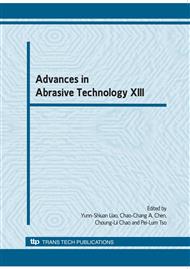p.855
p.861
p.867
p.873
p.879
p.885
p.891
p.899
p.905
A Study of Uncut Chips Produced by CNT Grinding Wheel
Abstract:
Nano structures such as CNTs were proposed to be directly used as cutting grains to fully utilize the nice mechanical and thermal properties for nano machining. To further understand the CNT abrasive tool, a theoretical study of the CNT uncut chip model was conducted together with preliminary experimental tests to investigate the chip generation in the nano machining process. We found that the CNT distribution was not even in the CNT layer of the wheel. Based this finding, a grain spacing model and a feed of workpiece per cutting edge model were developed. Theoretical results were all very small. It was also found that individual workpiece chips were difficult to find due to small sizes. Further work is necessary. Furthermore, Chip gelling effect was found. The reasons were due to agglomeration and epoxy melting. Experimental results were found agree with our theoretical results.
Info:
Periodical:
Pages:
879-884
Citation:
Online since:
August 2010
Keywords:
Price:
Сopyright:
© 2010 Trans Tech Publications Ltd. All Rights Reserved
Share:
Citation:


